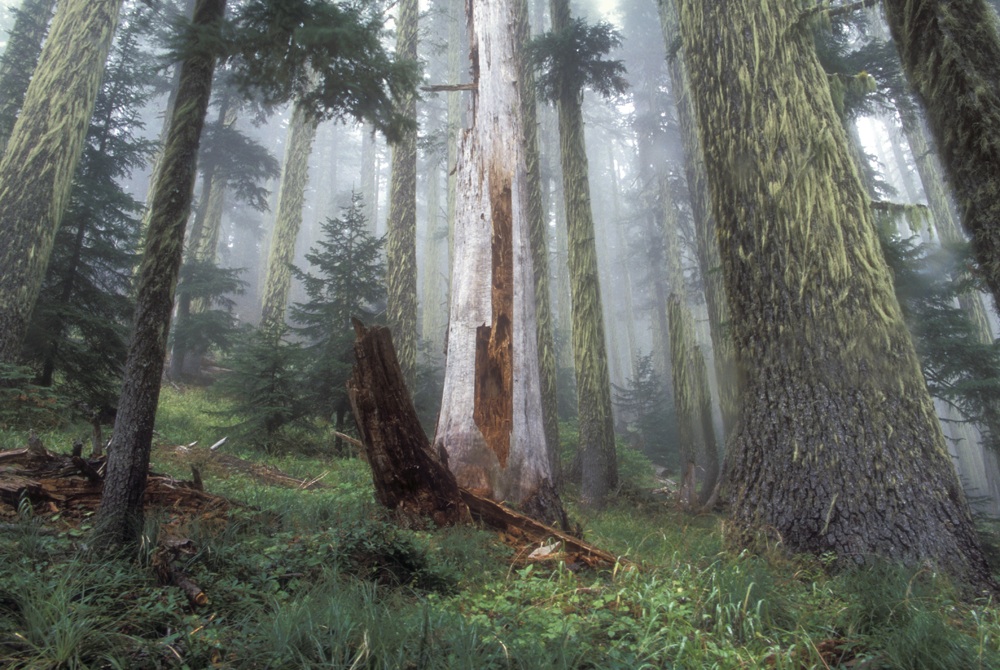Temperate Rainforests of the Cascadia Bioregion – Towering Douglas fir trees, colorful vine maples, and wet ferns define and shape life here. These diverse forests provide wildlife habitat, food, clean drinking water, and unrivaled beauty. For thousands of years, the abundance these forests have generated has been intentionally cultivated and shaped by the peoples native to these lands. Tribal entities continue to hold and manage forests in this region, though their land holdings were dramatically reduced by the forced removal and the famine, death, and cultural and ecological destruction wrought by colonial expansion.
One legacy of this colonial expansion is the ongoing systematic logging of the towering trees that shelter this region. This logging — particularly clear-cutting — has wrought tremendous damage. Salmon runs have been decimated, drinking water compromised, and the dense, industrial mono-culture tree farms that now dominate the landscape fuel large catastrophic forest fires. However, well managed forests that reincorporate Traditional Ecological Knowledge and indigenous burning practices can also provide much-needed wildlife habitat, quality recreational experiences, sustainable jobs, and capture and hold carbon dioxide at rates equivalent to the Amazon rainforest. Cascadia Wildlands fully understands that responsible forest management involves an appropriate balance between all the values these forests generously offer.
Cascadia Wildlands was formed in 1998 to prevent the industrial clearcutting of temperate ancient forests. In response to this ongoing threat, we devote much of our efforts toward protecting the older forests of our bioregion as they are critical, not just to the survival of species teetering on the brink of extinction, but to the shared history and future of all the people who live here.
Our efforts on public lands — mostly held in trust by the Bureau of Land Management, US Forest Service and various state agencies — also address issues of use such as roads, pipelines, and mining. We are currently monitoring, field checking, and litigating reckless logging and development proposals in older forests across jurisdictions and ecosystems, in places including the Willamette and Umpqua National Forests, and various western Oregon Bureau of Land Management Districts, as well as Oregon’s public state forests. Learn more about our Federal Forest work here.
Cascadia Wildlands works across the Cascadia bioregion to forward sustainable forest policies and practices as well as ensure all of Cascadia’s human residents and visitors continue to have access to intact ecosystems and world-class recreation experiences. We take a multi-pronged approach to this work, utilizing the public process, policy, on the ground fact checking and strategic litigation. Learn about our tactics for change for more information about how we work to defend Cascadia’s forests.
Forest Policy
From time to time, federal and state agencies undertake policy initiatives that ultimately impact large expanses of the public lands these agencies manage for long periods of time. The consequences of these activities can be greatly beneficial for our forests, such as the creation of the National Refuge System and establishment of new National Monuments, or massively damaging like so-called “salvage logging” proposals after wildfire. Unfortunately, economic conditions including rural under-employment and the need to generate revenues are currently being used as rationales for ill-advised and unsustainable policies that benefit Wall Street timber corporations, not communities in the Pacific Northwest.
Cascadia Wildlands is fully engaged in making sure that common-sense and long-term conservation vision are not abandoned in this head-long rush to accelerate exploitation of our forests instead of taking key actions that will ensure solvency for fiscally challenged counties, promote quality educational and recreational opportunities, and protect natural values. In this vein, Cascadia Wildlands is involved in the revision and reformation of forest management plans on (1) Bureau of Land Management and National Forest lands — which total over 20 million acres in our region, (2) State Forests, (3) across private industrial timberlands.
Current Forest Campaigns
Tracking State Forests
Monitoring Federal Forests
Reforming Private Industrial Forestlands
Creating Permanent Protections
Past Forest Campaigns
Safeguarding the Tongass National Forest
The Need for New Wildernesses
A Wilderness designation is the utmost protection Congress can afford an area on federal public land. Simply put, it is a place where mechanization is not allowed and a place where wild nature is left alone for its own intrinsic value. Cascadia Wildlands believes that all people deserve access to intact ecosystems. We are also celebrating our recent victory — the newly designated Devil’s Staircase Wilderness in the Oregon Coast Range, and Wild Rogue Wilderness in the Siskiyou Mountains.

